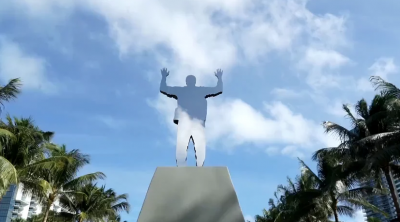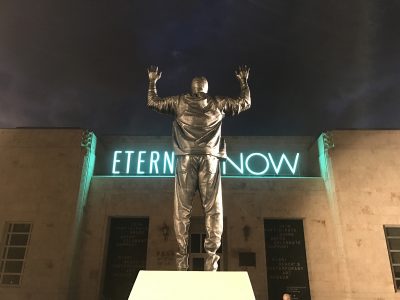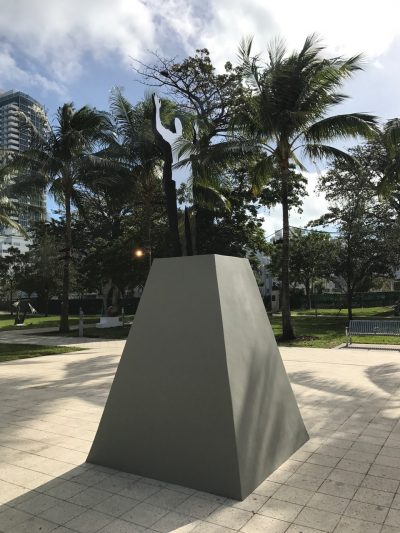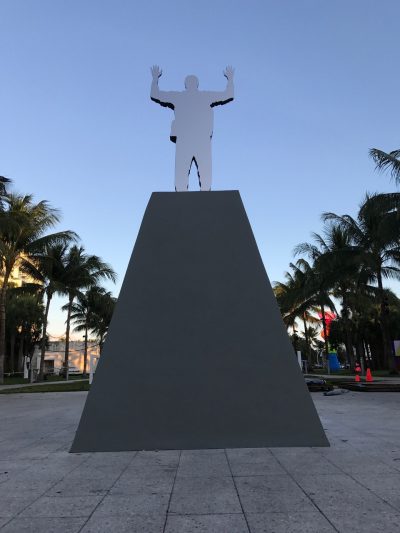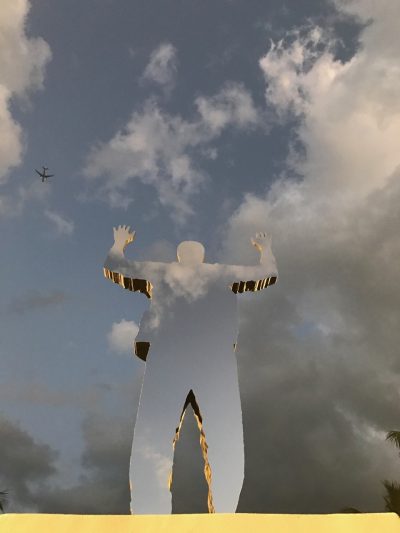Glenn Kaino – Invisible Man
Please update your browser to access Creative Exchange Agency.
Glenn Kaino presents Invisible Man, a monument and void entwined in service of illuminating perspective. Atop the pedestal base stands a man with his hands up, a pose which signals surrender, contrary to the subjects of most public monuments. Initially seeing the figure from behind, as you circle the statue to see the front, it disappears from sight - an illusion leaving the viewer with an empty pedestal. Creating this effect by way of a mirrored surface, depending on vantage point, the viewer may also be confronted with a reflection of themselves. Its title referencing Ralph Ellison’s classic novel about visibility and race, Invisible Man serves as a monument to the forgotten and ignored, an interrogation of the purpose of artistic commemoration as a means towards cultural catharsis, and the political implications of canonizing figures in public spaces. Though it is said that a memorial immortalizes its subjects, memorials are ultimately objects which can be destroyed - statues living and dying with the mercurial political conditions which allowed them to come into existence. Literally faceless by nature of the illusion, the figure nevertheless stands resolute, stoic even in this active erasure. By way of this conviction, the symbol of surrender instead emerges as an icon of defiance. More
Glenn Kaino presents Invisible Man, a monument and void entwined in service of illuminating perspective. Atop the pedestal base stands a man with his hands up, a pose which signals surrender, contrary to the subjects of most public monuments. Initially seeing the figure from behind, as you circle the statue to see the front, it disappears from sight - an illusion leaving the viewer with an empty pedestal. Creating this effect by way of a mirrored surface, depending on vantage point, the viewer may also be confronted with a reflection of themselves. Its title referencing Ralph Ellison’s classic novel about visibility and race, Invisible Man serves as a monument to the forgotten and ignored, an interrogation of the purpose of artistic commemoration as a means towards cultural catharsis, and the political implications of canonizing figures in public spaces. Though it is said that a memorial immortalizes its subjects, memorials are ultimately objects which can be destroyed - statues living and dying with the mercurial political conditions which allowed them to come into existence. Literally faceless by nature of the illusion, the figure nevertheless stands resolute, stoic even in this active erasure. By way of this conviction, the symbol of surrender instead emerges as an icon of defiance. More
Glenn Kaino presents Invisible Man, a monument and void entwined in service of illuminating perspective. Atop the pedestal base stands a man with his hands up, a pose which signals surrender, contrary to the subjects of most public monuments. Initially seeing the figure from behind, as you circle the statue to see the front, it disappears from sight - an illusion leaving the viewer with an empty pedestal. Creating this effect by way of a mirrored surface, depending on vantage point, the viewer may also be confronted with a reflection of themselves. Its title referencing Ralph Ellison’s classic novel about visibility and race, Invisible Man serves as a monument to the forgotten and ignored, an interrogation of the purpose of artistic commemoration as a means towards cultural catharsis, and the political implications of canonizing figures in public spaces. Though it is said that a memorial immortalizes its subjects, memorials are ultimately objects which can be destroyed - statues living and dying with the mercurial political conditions which allowed them to come into existence. Literally faceless by nature of the illusion, the figure nevertheless stands resolute, stoic even in this active erasure. By way of this conviction, the symbol of surrender instead emerges as an icon of defiance. More
Glenn Kaino presents Invisible Man, a monument and void entwined in service of illuminating perspective. Atop the pedestal base stands a man with his hands up, a pose which signals surrender, contrary to the subjects of most public monuments. Initially seeing the figure from behind, as you circle the statue to see the front, it disappears from sight - an illusion leaving the viewer with an empty pedestal. Creating this effect by way of a mirrored surface, depending on vantage point, the viewer may also be confronted with a reflection of themselves. Its title referencing Ralph Ellison’s classic novel about visibility and race, Invisible Man serves as a monument to the forgotten and ignored, an interrogation of the purpose of artistic commemoration as a means towards cultural catharsis, and the political implications of canonizing figures in public spaces. Though it is said that a memorial immortalizes its subjects, memorials are ultimately objects which can be destroyed - statues living and dying with the mercurial political conditions which allowed them to come into existence. Literally faceless by nature of the illusion, the figure nevertheless stands resolute, stoic even in this active erasure. By way of this conviction, the symbol of surrender instead emerges as an icon of defiance. More
Glenn Kaino presents Invisible Man, a monument and void entwined in service of illuminating perspective. Atop the pedestal base stands a man with his hands up, a pose which signals surrender, contrary to the subjects of most public monuments. Initially seeing the figure from behind, as you circle the statue to see the front, it disappears from sight - an illusion leaving the viewer with an empty pedestal. Creating this effect by way of a mirrored surface, depending on vantage point, the viewer may also be confronted with a reflection of themselves. Its title referencing Ralph Ellison’s classic novel about visibility and race, Invisible Man serves as a monument to the forgotten and ignored, an interrogation of the purpose of artistic commemoration as a means towards cultural catharsis, and the political implications of canonizing figures in public spaces. Though it is said that a memorial immortalizes its subjects, memorials are ultimately objects which can be destroyed - statues living and dying with the mercurial political conditions which allowed them to come into existence. Literally faceless by nature of the illusion, the figure nevertheless stands resolute, stoic even in this active erasure. By way of this conviction, the symbol of surrender instead emerges as an icon of defiance. More
Glenn Kaino presents Invisible Man, a monument and void entwined in service of illuminating perspective. Atop the pedestal base stands a man with his hands up, a pose which signals surrender, contrary to the subjects of most public monuments. Initially seeing the figure from behind, as you circle the statue to see the front, it disappears from sight - an illusion leaving the viewer with an empty pedestal. Creating this effect by way of a mirrored surface, depending on vantage point, the viewer may also be confronted with a reflection of themselves. Its title referencing Ralph Ellison’s classic novel about visibility and race, Invisible Man serves as a monument to the forgotten and ignored, an interrogation of the purpose of artistic commemoration as a means towards cultural catharsis, and the political implications of canonizing figures in public spaces. Though it is said that a memorial immortalizes its subjects, memorials are ultimately objects which can be destroyed - statues living and dying with the mercurial political conditions which allowed them to come into existence. Literally faceless by nature of the illusion, the figure nevertheless stands resolute, stoic even in this active erasure. By way of this conviction, the symbol of surrender instead emerges as an icon of defiance. More





